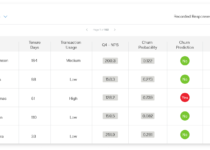Neuro-Marketing: The Future of Marketing Strategies for Engaging Consumers
What is Neuro-Marketing?
Neuromarketing, also known as consumer neuroscience, uses elements of neuroscience to study people’s sensorimotor, cognitive and emotional reactions to marketing. It enhances traditional methods of market research like surveys and focus groups, which only incorporate conscious answers, by looking at the underlying decision making processes.
To comprehend the meaning of neuromarketing – how our brain responds to marketing messages – with the aim of developing effective campaigns that are based nerve racking marketing strategies and are persuasive beyond logical comprehension. This helps companies to better understand and shape consumer behavior and formulate strategies that address pertinent issues and concerns in a timely manner.
Neuromarketing seeks to answer questions like: Which area of the brain experiences activity when a consumer is presented with a certain advertisement? What is the impact of different colors, sounds, and texture on emotions? By understanding these factors, marketers can devise more efficient impact-driven strategies.
The Science Behind Neuro-Marketing
The core foundation of neuromarketing is how a person’s brain comprehends information and the decisions they make afterward. It employs fundamental parts of psychology and neuroscience such as:
- Emotional Processing: Emotions play a crucial role in decision-making. Neuromarketing investigates how specific emotions, such as joy, fear, or trust, are triggered by marketing stimuli and how these emotions influence purchasing behavior.
- Cognitive Biases: Along with confirmation bias (searching for and applying information that reinforces pre-existing beliefs) and anchoring bias (the tendency to overly depend on the first piece of information encountered), our brains are also affected by many other cognitive biases. Neuromarketing seeks to identify these biases and exploit them for marketing purposes.
- Sensory Perception: The way we view the world affects our emotions as well as our buying decisions profoundly. These are the five senses: hearing, touching, tasting, smelling, and seeing. Neuromarketing investigates how sensory stimuli can be purposefully programmed to create a favorable impression of a certain brand or product. This is where studying neuromarketing comes in handy.
Top Neuro-Marketing Strategies Brands Use
To reach customers at a deeper level and appeal to their subconscious and emotions, brands use a variety of neuromarketing strategies. The list of such techniques is constantly being updated with new innovations provided by science and technology. These are some of the most popular neuromarketing strategies:
1. Color Psychology in Branding:
The colors of the brand Standard Oil Company incorporating red identified with the flagship logo of an oil transport company; blue is used to signify oil tanks and pipelines; green symbolises main product – oil; yellow is associated with gasoline which is widely sold through their branded stations.
These colors evoke very strong emotional responses. For example, red is associated with the enhancement of appetite or excitement, blue is associated with stability and trust, while green is associated with nature. Companies choose colors for their logos, advertising products and packages very carefully so that they will be in accordance with the company’s goals and create necessary feelings.
2. Emotional Marketing:
As we have seen, ads can still be made using emotional appeals because storytelling, imagery, and music evoke some feelings that link them to the brand. Those ads can be more effective if they incorporate a more powerful campaign that can get a person’s attention.
3. Storytelling & Narrative Marketing:
Our brains are wired to stories, we respond to them. Narrative marketing takes the best of the brand and adds the best narrative to capture the audience’s emotions, connect them, and remember them more easily.
4. Scarcity & Urgency Triggers:
The sales strategies that put limit on time and quantity trigger people’s urge to take action due to missing out. They establish motivation through limited time offers, countdown timer, and quantities for sale. Which makes it easier to motivate consumers to perform an immediate action.
5. Sensory Marketing:
Using scents to engage the luxury brand creates an immersive experience and enhances comfort level. In stores of luxury retailers, specific types of scents and music is played to create a desirable brand atmosphere.
6. Social Proof & Influencer Marketing:
Other people’s behaviors affect us greatly. In these cases, endorsements, reviews and others’ social proof can serve to build their celebrities’ credibility as it can easily influence the trust.
7. Eye-Tracking & Biometric Analysis:
Consumer’s life experience makes these modern devices valuable for any marketer. Heart rate, skin conductance, and eye-tracking reveals the consumers focus attention and their emotional responses.
Real-World Examples of Neuro-Marketing in Action
- Frito-Lay: Frito-Lay found in fMRI research that the rustle of their chip bag provoked an intense ‘hungry’ feeling. They began using this specific sound in their promotional material.
- PayPal: PayPal’s advertisements focused on the instant gratification provided by their online payment system by highlighting how easy it was to use.
- Cheetos: Cheetos captured the fun and “guilty pleasure” of snacking on cheetos and advertised without apology the playful bonanaza of orange dust on their hands after eating.
Top Benefits of Neuromarketing for Brands
The advantages of incorporating neuromarketing into a marketing strategy are numerous:
Improved Campaign Effectiveness:
Marketers can create better targeted campaigns that resonate with the audience as a result of understanding the neurological and psychological triggers of consumer behavior, improving campaign effectiveness.
Increased ROI:
As a consequence of more effective campaigns, conversion rates, sales, and the return on investment will increase, all leading to a better ROI.
Stronger Brand Connections:
Consumers are aid to foster brand loyalty and advocates also aided through forming deeper emotional relations with the brand, which allows stronger brand connections enabling.
Better Product Development:
Products will be better developed by these insights indeed so neuromarketing will ensure causing products to be designed to meet subconscious needs and desires of consumer, informing product development and innovation.
Competitive Advantage:
Brands using neuromarketing strategies have a clear understanding of their target audiences’ behavior and therefore are able to gain a competitive edge over their rivals.
Top Neuromarketing Techniques Brands Use That Work
A variety of neuromarketing techniques provide valuable data on consumer behavior:
1. fMRI (functional Magnetic Resonance Imaging):
Determines brain activity by measuring blood flow. It offers insight into what portions of the brain are activated during marketing activities.
2. EEG (Electroencephalography):
Records electrical activity in the brain, demonstrating features of the processes of cognition such as attention and involvement.
3. Eye-Tracking:
Determines the area of focus of a consumer’s eyes on a webpage, advertisement or package.
4. Biometric Measurements:
Heart rate, skin conductance (sweating), and facial expression are some of the more basic ways to measure emotional responses and arousal.
5. Implicit Association Test (IAT):
Measures the association between concepts such as a brand and positive emotions.
Future of Neuro-Marketing: What’s Next?
There is a world of opportunity for the future of neuromarketing. New innovational advances in AI and machine learning as well as virtual reality will most likely enable an even more complex and refined approach to marketing. The following points will likely occur:
- Increased Personalization: Einstein Algorithms based on AI will sort individual data into groups of consumers and, using marketing automation systems, create and tailor messages and suggestions specific to each marketing objective.
- Immersive Experiences: The consumer experience will improve significantly as a result of using VR and AR technologies, further engaging consumers at a profound emotional level.
- Predictive Analytics: Marketers will be able to accurately forecast consumer behavior thanks to the fusion of Neuromarketing data with machine learning.
- Ethical Considerations and Regulations: The more neuromarketing advances, the greater the need for ethical standards and regulations will become as well.
Frequently Asked Questions (FAQs)
1. Is neuro-marketing ethical?
Neuro-marketing incorporates marketing and neuroscience, which raises ethical issues associated with consumers being manipulated using psychological techniques. It appears that ethical lines are crossed when neuroscience is applied to understanding consumer behavior, especially with the attempt to influence automatic decisions made below the level of conscious awareness.
Striking an ethical balance brings up the issues of endangering those classifiable as mentally subordinate, mental privacy violation, and exploitation without adequate consent. Responsible practices must provide full disclosure, respect the independence of the consumers, and reconfirm that these insights will not be used to undermine their intent.
2. How does neuro-marketing differ from traditional marketing?
The difference in neuro-marketing techniques compared to traditional marketing is that it uses the most modern scientific approaches to study the behaviors of consumers. While traditional marketing makes use of elementary methods like surveys and focus groups, neuro-marketing utilizes more advanced techniques such as fMRI and EEG which measure subconscious brain activity.
This enables marketers to obtain deep and accurate insights into the emotions, reactions, and decision-making processes of individuals. In marketing, there is a gap between what consumers say they intend to buy and what they actually buy – neuro-marketing closes this gap by understanding the consumer’s brain and emotions.
3. Can small businesses use neuro-marketing strategies?
These strategies are too advanced for traditional small businesses, but they can still utilize them in simpler and inexpensive ways. These methods include applying color theory in branding, designing websites through the lens of cognitive psychology, emotionally charged storytelling, and employing inexpensive eye-tracking technologies.
Smaller businesses have the needed financial freedom, yet gain valuable consumer behavior insights by understanding cognitive biases, implementing strategic design elements, and creating effective marketing materials at an affordable price. The strategies need to be incremental, starting small in order to stimulate valuable insights into customer decision-making.
4. What are the best tools for implementing neuro-marketing?
The best tools for implementing neuro-marketing range from highly sophisticated technological to everyday solutions. The more expensive ones comprise of EEG headsets, advanced biometrics, eye-tracking software, facial recognition, and glasses with built-in camera systems that measure multiple body functions. With more modest funds, devices such as the Tobii Eye Tracker, Emotiv EPOC headset, and even simple Google Analytics can bring important insights when it comes to neurological marketing.
Some relatively new tools provide detailed brain response mapping, while the less expensive options concentrate on tracking behavior and emotional response. Decisions made on tools will depend on particular research needs, budget limits, and levels of insight demanded by the business.
Conclusion
With the aid of ideography, neuromarketing helps target advertisement strategies to the deepest understanding of consumer’s needs and perceptions. It assists brands that harness the hitherto untapped touches of neuroscience and psychology to achieve greater efficacy in marketing activities, strengthen brand loyalty and positively influence business outcomes.
However, when it comes to ethical issues the balance needs to be tipped one way, but it’s possible to see the innovation of neuromarketing trending upwards by improving lease for the customer experience and the marketing world as a whole.
Technology growth suggests an achievable claim that gradually, neuromarketing will become an essential attachment to advanced branded articulations as a means for deep level connections to be made. If the limits of Neuromarketing are crossed, business will always be strategized competitively while ensuring that proper ties with the customer base are formed.
The post Neuro-Marketing: The Future of Marketing Strategies for Engaging Consumers appeared first on Aumcore.


